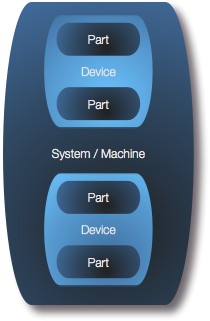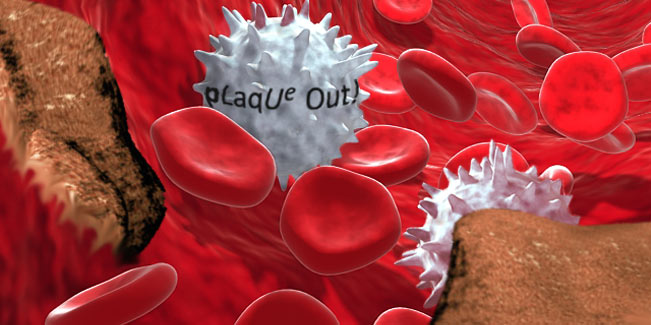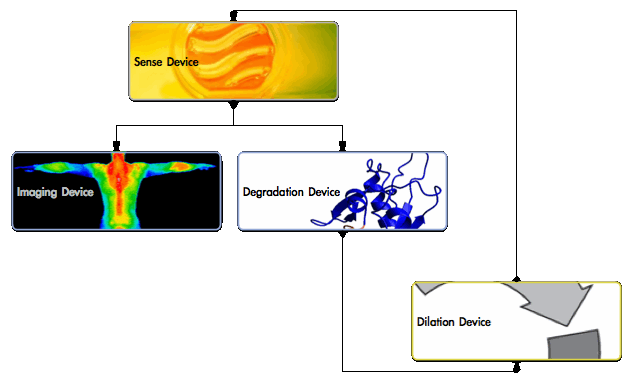Team:NTU-Singapore/Project/System
From 2009.igem.org
Our Solution
In the previous section, we identified some characteristic conditions present at atherosclerotic sites. Now we will start formulating a solution in the framework of a system. We will use an engineering approach.
This approach suits the purposes of iGEM and Registry of Biological Parts very well, because the aim of synthetic biology is to systemize biology. This will empower us to engineer biological solutions to problems.
Parts, devices & systems
The first step to systemizing would be to recognize that any system is made up of devices, which in turn consist of parts. This is known as an abstraction hierarchy.
In the context of iGEM, parts would be functional gene sequences, devices would be individual Biobricks, and the resulting system is a coherent & working biological machine.
The purpose of an abstraction hierarchy is simple. By abstracting a synthetic genome into these layers, we can start to blackbox and isolate the gene sequences or the functions that we are interested in. This means, at every level in the hierarchy, one need only concentrate on the workings of that layer and nothing else. For example, someone making a circuit does not need to know the inner workings of a battery or the switch. He/she can just expect it to work in a predictable way.
Similarly, someone working on a biological device does not have to worry about the details of the parts being used and so on.
This modularization is made possible with Biobricks, bringing us one step closer to Tom Knight's dream of plug-and-play biology. In this way, synthetic biology can be advanced in the same reductionistic way that has best suited the study of biology.
The Engineering Approach
Now that we understand what systemizing means, let's look at how we can use systems/sub-systems (devices) in the engineering process. Below is the typical flow of the engineering process. We have, in order of sequence:
- Problem Identification : In our case, we recognize atherosclerosis as our problem.
- System Specifications : We will identify the parameters that can be manipulated or need to be controlled.
- System Design : We will propose and design a system to solve the problem.
- Device Design : Design devices (and parts) that, when combined, fulfill the specifications of our system.
- Modelling : We simultaneously model both the system & its devices to identify bottlenecks.
- Prototyping : We will make a proof-of-concept that highlights the potential engineering difficulties.
- System Construction : If the prototype is successful, we can actually construct the intended system.
- Testing & Characterisation : We verify the functionality of our system & compare to the modelling.
So let's start to analyze our problem, atherosclerotic plaque, and layout our proposed solution according to these steps.
System Specifications
We have already identified the problem and collated its characteristics. So the logical next step is to define the system parameters or system specifications. Each of these parameters are chosen from the analysis of characteristics of physiological plaque inflammation.
In general, our defined parameters will outline what exactly our system is going to do to achieve the goal of imaging and breaking down plaque in vivo.
From our research, we propose the following as the system parameters:
- Our system must sense changes in blood [NO]. If it falls below a certain level, then system is triggered to switch on.
- Since our system will also be selective to damaged arterial walls thanks to catch bonds, we can be fairly certain of the specificity of our system to atherosclerotic plaque sites.
- The system must release enzymes to breakdown the cholesteryl esters in plaque.
- The system must additionally release a reporter protein that allows for for in vivo visualisation.
- This is to enable easy and early diagnosis.
- The system must re-generate [NO] at site.
- Not only does this dilate the vessel, it also serves as feedback to the system to shut down.
Now that we have defined our system parameters, we can decide on the parts and devices we can use to build our system from scratch.
Ideal System Design
We can generally agree at this stage, that our ideal system must be based in a mammalian blood cell; the function and requirements of the system specifications demand such an approach. Ideally a T-helper cell would be used. The advantage of using a T-helper cell is that expression/exhibition of PSGL-1 at the surface becomes trivial.
The team also decided that each of the four specifications should be satisfied by four separate constructs in a genetic activation/repression circuit. These would be the devices that make up our system.
We have defined the four devices as the following:
- Sensing device : To detect changes in physiological blood [NO].
- Degradation device : To secrete cholesterol esterase to break down the lipid core.
- Imaging device : To identify and monitor plaque sites in vivo.
- Dilation device : To re-generate [NO] & feedback to shutdown.
Here's how we see our system working.
- Our system is injected into the bloodstream anywhere in the body.
- The Sensing device actively samples the blood [NO].
- In healthy [NO] conditions, our Sense device actively inhibits the functioning of the other devices.
- Once blood [NO] falls to critical levels, our Sense device is de-activated, and the other devices are not inhibited anymore.
- We also expect that our system would bind selectively to the damaged endothelium at the plaque site.
- The Degradation device releases cholesterol esterase into the plaque.
- The Imaging device releases a reporter protein that can be imaged in vivo.
- We have identified a protein expressly for this purpose. It will be detailed in the next section.
- After a programmed delay mechanism, the Dilation device will start to release an enzyme to re-generate [NO] at the plaque site.
Each of these devices will be the final construct-Biobricks that we intend to achieve. We have to now populate these devices with the parts to make the device work the way we want them to.
Unfortunately, our laboratories are not sufficiently equipped to deal with mammalian cells. We also felt that the iGEM time period is not sufficient to make a mammalian biological system. Due to these time and equipment constraints, we will not detail the devices of the ideal system, since we will not be able to build it anyway.
Instead, we will focus on designing a full-blown prototype system as a proof-of-concept, using E.Coli as our model organism.
Fulfilling the parameters
Now that we have defined the parameters of our system, we can list our objectives and try to satisfy them systematically. The next step is to do a thorough literature review to identify parts that will help us to achieve our objectives. The fruits of our labour are detailed within the Research Proposal.
Please proceed here to read our Research Proposal.
Literature / References
Please proceed here to view our full list of references.
 "
"



